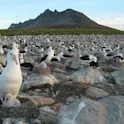
Sustainability
24 Oct 2017
Waterside lighting drastically disrupts wildlife in the surrounding ecosystem
Streetlights affect insects and spiders living beneath the lights, finds a study in Frontiers in Environmental Science

Sustainability
24 Oct 2017
Streetlights affect insects and spiders living beneath the lights, finds a study in Frontiers in Environmental Science

Environment
09 Oct 2017
A new, non-intrusive way to assess seabird diet could help improve fisheries management and monitor marine biodiversity.

Environment
09 Aug 2017
Frontiers in Marine Science is proud to launch the second edition of our annual Research Topic: Horizon Scan 2018: Emerging Issues in Marine Science.

Frontiers news
11 Oct 2016
Frontiers for Young Minds is proud and excited to announce the launch of its newest specialty section, Understanding Biodiversity. This new specialty will be led by the Specialty Chief Editor Chelsea Specht of UC Berkeley and will provide articles that help our curious young readers to better understand the biological diversity that exists on our planet! The Understanding Biodiversity specialty is now open for submissions and will publish articles with the following scope: Biology is the study of life, and what could be more important than that? When scientists study the variety of life – called biodiversity – they can use tools from ecology, evolution, conservation, genetics, and even the management of our natural resources. They find and describe new species, explore uncharted ecosystems, study how and why species change, investigate patterns in where and when species live, and study processes that make it possible for an ecosystem to survive or thrive. This section of Frontiers for Young Minds will include articles that describe, explore, and explain biological diversity on Earth – past, present, and future. From paleontology to botany to zoology (all animals big and small, from elephants to microbes), articles will address how living things adapt, change, and use […]

Life sciences
05 Aug 2016
The preference of Heliconius butterflies for certain leaf shapes is innate, but can be reversed through learning, says a study in Frontiers in Ecology and Evolution. These results support a decades-old theory for explaining the evolution of the exceptional diversity of leaf shapes in passionflowers. The tropical butterfly Heliconius eratodistinguishes between shapes, and uses them as a cue for choosing the plants on which to feed and lay eggs, shows new research by scientists from the University of Cambridge and the Smithsonian Tropical Research Institute. The butterfly has an innate preference for passionflowers with particular leaf shapes, but can learn to overcome this preference in favor of other shapes, especially those that are the most abundant in the local flora. These preferences can promote the evolution of plant biodiversity. Heliconius erato, the red passionflower butterfly, is a large (5 to 8 cm wingspan), white-red-black butterfly that occurs throughout Central America and tropical South America. Females lay their eggs on passionflowers (Passiflora), a genus of tropical vines with extreme variation in leaf shape, both between and within species. For example, related species can have triangular, elongated, elliptic, lobed, or spear-shaped leaves, while even on the same plant leaf shape may vary […]
Get the latest research updates, subscribe to our newsletter